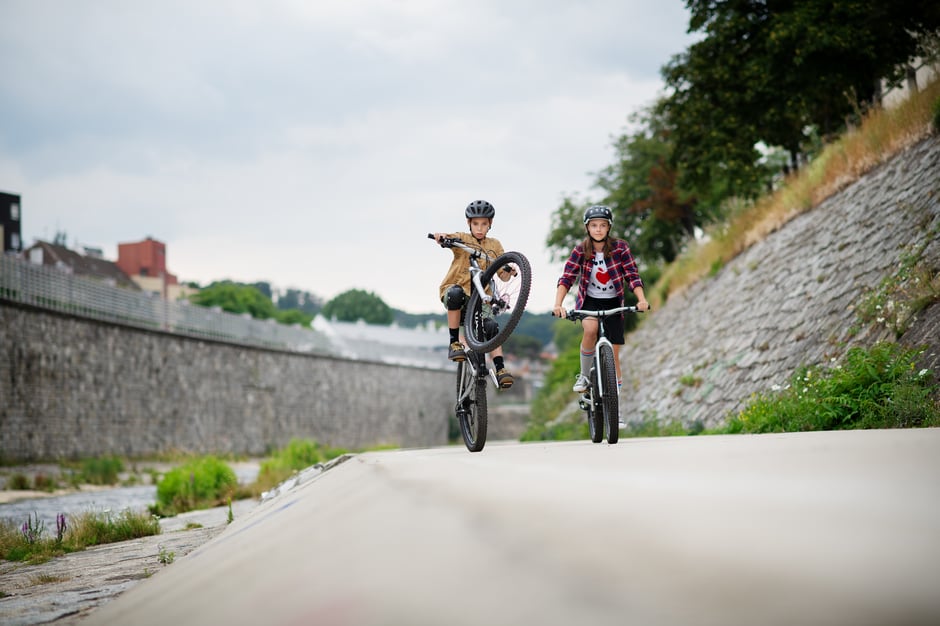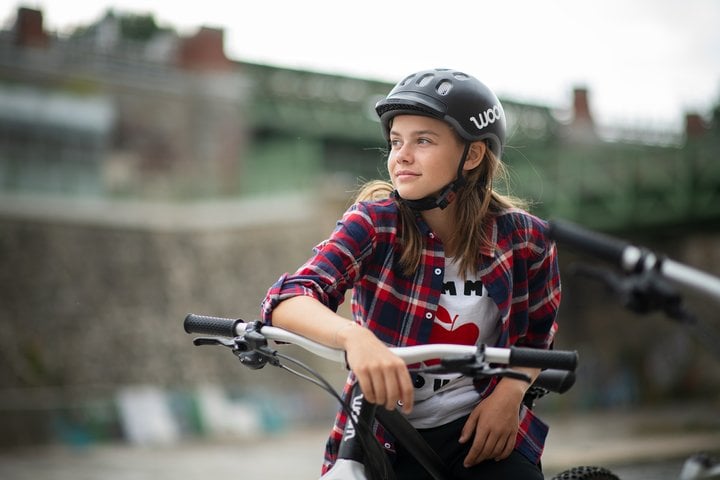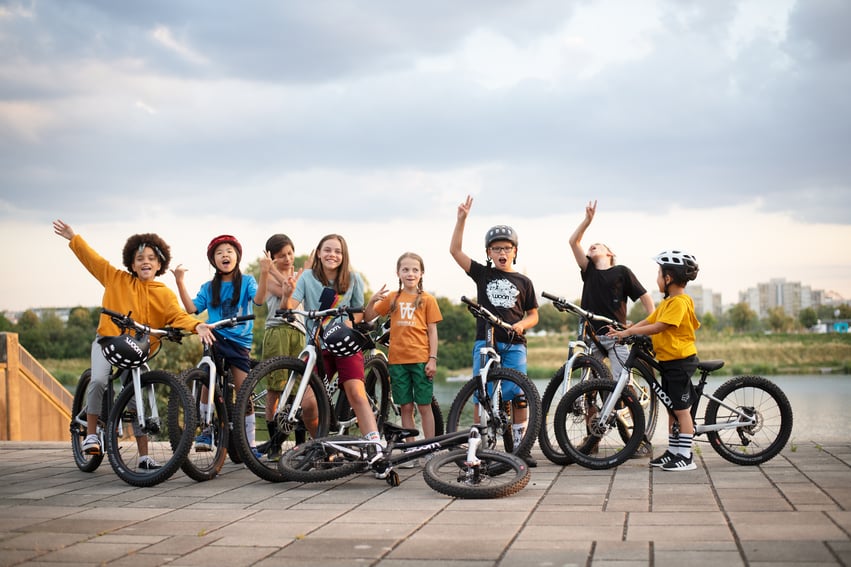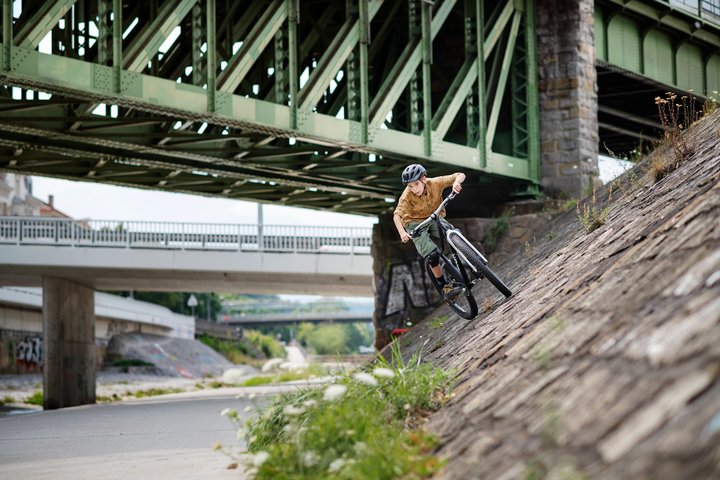Just because mountain bikes are in their element away from the tarmac and up on the hills, it does not mean that your offspring cannot use their beloved bike on a day-to-day basis. Definitely not!
Fair enough, mountain bikes are built to excel on rough, loose terrain. That's exactly why they come with formidable features like wide, knobbly tyres, robust frames, gearing that’s intended for steep gradients, and often disc brakes and suspension. But even in towns and cities, mountain bikes have a number of ace cards to play when on the tarmac. Keep reading to find out more...
The athletic geometry of mountain bikes creates a lightly stretched-out position. By lowering your centre of gravity, the rider is positioned centrally over the bottom bracket; there are numerous physiological benefits for your child when they adopt this dynamic and forward position:
- Body weight is optimally distributed over the three contact points: bars, saddle, and pedals. The rider’s neck, shoulders, feet and hands are more efficient supports compared to an upright position, which reduces pressure on the rider’s back, spine and sit bones.
- There is less load on the spine during long rides – it remains in a natural S-shaped position, allowing full movement and the optimal buffer effect over bumps.
- Your child’s power transfer onto pedals is at its most effective (provided that the saddle is also optimally positioned).
- Due to the fact that various muscle groups are activated in this position, your child won’t tire so quickly. This means you’ll be able to cover greater distances together in your town.

But is it not more comfortable to ride in an upright position? Initially, yes. But consider that you’re constantly in movement on the bike, and we are not talking about a static sitting position like in a chair. Many muscles are involved to compensate for the forces that are at play while riding, and to make sure that you’re comfortable. By adopting a very upright position, your sit bones have to take the load of almost your entire body weight. Your back muscles will do all the stabilizing work in order to prevent your spinal column from curving or getting overly tired. In this position, your vertebral discs will be vulnerable to all the bumps and roughness of the terrain, with very little cushioning providing by the rest of your body. Over time, this will take its toll. Comfy, Dutch-style city bikes are therefore best kept for short distances on flat land.
Did someone say they were scared of tram tracks? No longer. With the chunkier mtb tyres and their wider surface area, the risk of losing a tyre in tram tracks is massively reduced. The same applies to pavements, potholes and slippery cobblestones – MTB tyres take it all in their stride, and even more so when teamed with a suspension fork. Speaking of suspension forks, city bikes have no need for such expensive and heavy components, as their more upright position means that there’s so little load over the bars that the suspension will barely function. This factor is even more significant for particularly light children.
Modern mountain bikes are equipped with powerful disc brakes that are specifically designed to cope with demanding off-road descents. However, such power is hugely advantageous for traffic, where unpredictable situations can occur. The brakes require nominal hand strength to perform effectively – one or two fingers will suffice to bring about the full braking power. This lets your child keep their hands firmly on the bars and concentrate on holding their line in the traffic. Another benefit comes into play in wet weather; disc brakes are proven to perform extremely reliably and effectively in wet conditions.
Do you live in a hilly town? If so, having the right gearing will come in very handy to tackle the climbs with ease. Once in the right gear, climbs become a piece of cake and gears even make it easier to ride on the flat. Make sure your child hits the right cadence; pedaling at a low frequency (i.e. riding in a big gear) on the flat should be avoided. If they can ride in a low gear with a high cadence they’ll find it easier and it’ll require less force, making it gentler on their knees, ankles, tendons and muscles. In terms of ergonomics, they should aim for a circular pedalling motion with even force throughout the stroke and a cadence of between 60 to 90 RPM.
Knowing the right gear for the right time is something that comes with practice. Remembering to shift in time for the start of a climb is not second nature for kids – in their early days, it might make a small hill feel like Mount Everest. Try and practice shifting in a safe, flat environment before heading into the hills. Check out this article for tips on training their shifting intuition.

IMPORTANT! Two more things and then you’re ready to roll:
- Turning a mountain bike into a ready-for-anything, year-round urban steed requires a few tweaks to make it truly roadworthy. As an offroader, it may not totally satisfy road traffic regulations. You may have to retrofit the following components: bell, lights, reflectors. Check your country’s guidelines for bicycle safety, such as these for the UK https://www.gov.uk/guidance/the-highway-code/rules-for-cyclists-59-to-82
Stand out on the roads: jazz up the bike with the addition of reflective stickers. See them as an opportunity for your child to exercise their creativity and add their own style to their bike. You can find a great deal of options on the internet and check out the range here https://rydesafe.com - Don’t forget to invest in a good bicycle lock; your child will want to keep their trusted partner safe and sound. Quality varies drastically when it comes to bike locks, so the investment is worth it. Cheap locks can be broken in a matter of seconds. An extra good theft-deterrent is to use two separate locks that function differently.


.jpg?width=926&upsize=true&name=woom_still_and_moving_in_action_2018_345-Edit-720x480-32ef3212-c95f-4d63-b83a-d57bf7c038f6%20(1).jpg)

